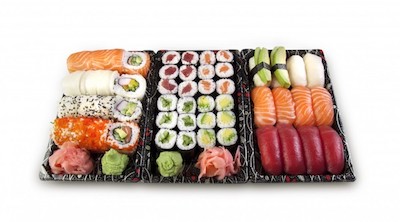We are reader supported. When you purchase through links on our site, we may earn an affiliate commission. Also, as an Amazon affiliate, we earn from qualifying purchases.
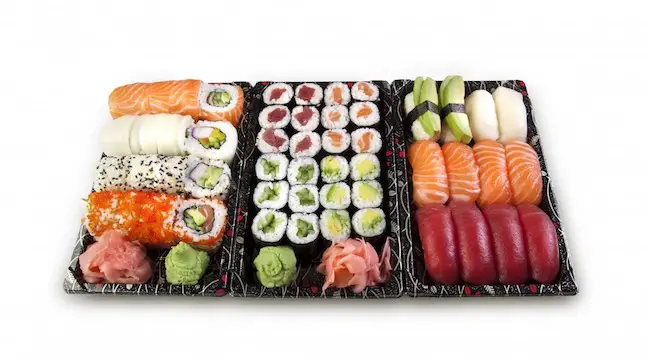
I am such a huge sushi fan that I love to make them at home every weekend to satisfy my incessant cravings and sail smoothly through the week. At home, we usually will gorge on the delicacy as long as there are fish or vegetable slices left on the tray or until our tummies can take no more.
I am often
The quantity may vary widely depending on the restaurant where you are eating, but one thing is for sure – you will mostly find them in even numbers such as 6, 8, 10, or 12 pieces. In a bento box, you can typically find about four pieces of sushi.
Contents
Understanding The Pieces or Portions Of Various Sushi Types
Besides the restaurant or bar’s own unique policy, the type of roll served may also determine the portions or pieces in a serving. A maki roll (hosomaki) comprising of just one filling is usually a thin roll that is cut into 6 or 8 pieces depending upon who’s rolling and what it contains inside.
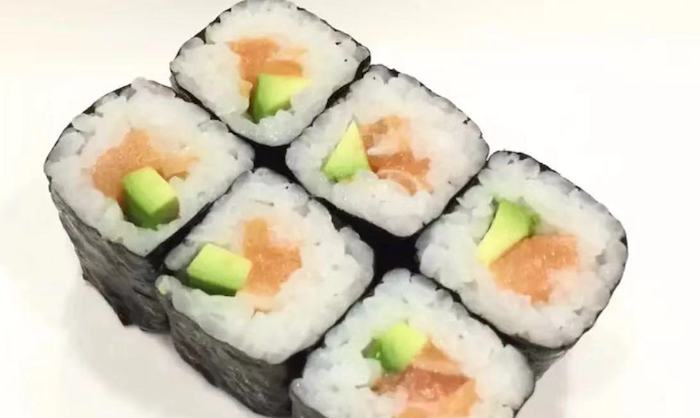
However, if your order includes a futomaki comprising of 4 or more fillings, it will be a big and thick roll cut into 4 pieces. Making thinner slices may risk the fillings or ingredients falling apart, so the less, the better. Also known as a specialty roll, futomaki rolls may sometimes be cut in half and served as 2 fat pieces.
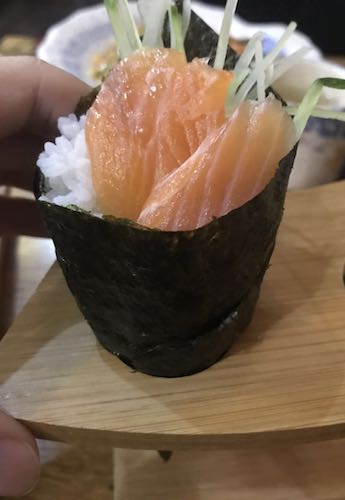
Temaki (see detailed explanation) is a special type of sushi that contains seasoned rice and filling inside. It is rolled in the shape of a cone and garnished with masago. Temaki may be made of a full nori sheet or mini temak rollis may be made from half nori sheets or a quarter-size nori sheet. It is served as one full portion.
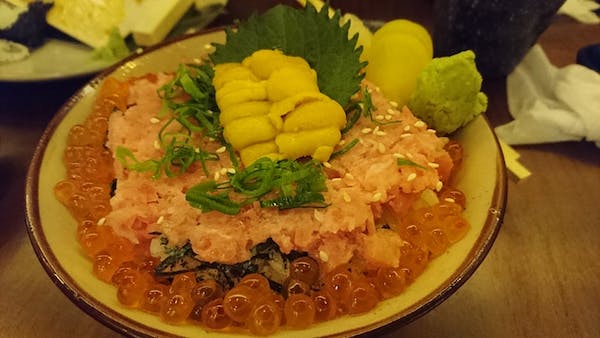
Chirashi is usually comprised of just one platter or bowl that contains an assortment of ingredients such as sushi rice, avocado slices, cucumber, raw fish, seafood, egg, and so on. This is one complete meal and not a sharing dish. I have spent 2 days to come up with a more detailed explanation about Chirashi. You must have a look at it.
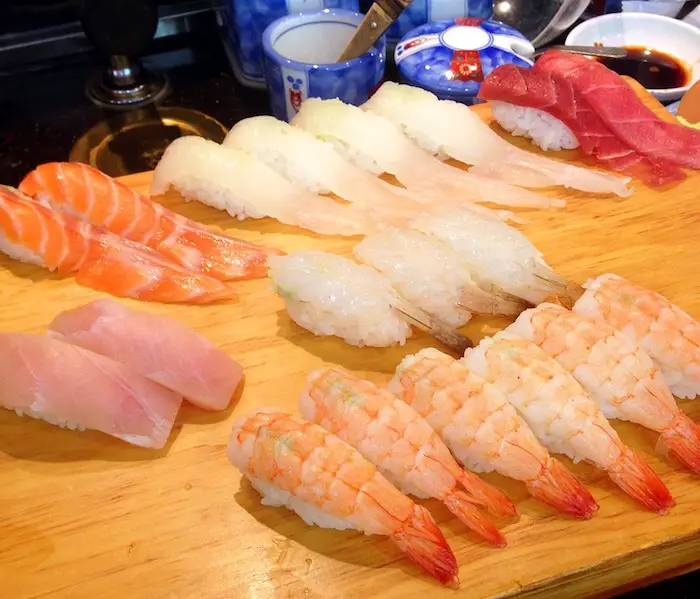
Nigiri sushi is typically served two pieces in a serving and they may or may not be the same fish. For example, you may get two pieces of nigiri sushi containing raw salmon or get one tuna and the other salmon.
How Many Pieces Are Served In A Sashimi Platter
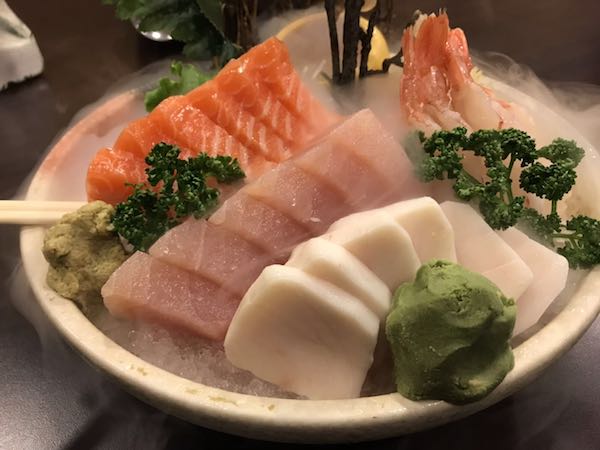
Let’s not forget sashimi, which is not sushi because it lacks nori and sushi rice, but since we are discussing the portions, I thought including sashimi would be a good idea. Sashimi roughly includes 5 pieces of the same fish species.
The thickness depends upon the restaurant and if the slices are too thick, they may serve 3 slices in a platter. As the number “4” is called “shi” in Japan, which is translated to death, this number is avoided at all places and occasions.
This is similar to the number “13” in America. So, in Japan, you will not find any hospital rooms with the number “4” on it and there will also not be 4 pieces on the sashimi platter.
Related Article: Difference Between Nigiri, Sashimi, Sushi Roll, Hand Roll, Gunkan Sushi
What Can You Expect To Find In A Typical Sushi Bar In Japan
In the outer circle of Tsijuki market in Tokyo, you will find several local eateries selling sushi during lunchtime. They usually offer at least two types of tuna – a fatty tuna (Chutoro or Otoro) and a lean tuna (Akami).
In the sushi bars, you can expect to find more varieties. Please note that freshwater eel is not sold in all sushi bars. Other common varieties worth exploring are salmon and salmon eggs (also referred to as salmon roe).
In the high-end sushi restaurants, you may expect to find Sea Urchin (see detailed explanation) gonads as one of the specialty delicacies on the menu. You will also find a better selection of raw fish and seafood.
How Much Sushi Should You Eat If You Are Watching Weight
If you are following a diet to get slim or simply watching weight to stay active, you will be happy to know that sushi is one of the lowest-calorie foods you can find. It is not deep fried, nor smothered in a lot of sauce. The fish slices do not have extra fat and they usually contain good fats such as omega-3 fatty acids.
The most common type of sushi you can find at any restaurant is the nigiri sushi that contains sushi rice and a small fillet of seafood or fish. Depending on the type of fish or seafood used, nigiri sushi may contain anywhere between 40 to 65 calories.
- 40 calories (scallop, squid)
- 50 calories (yellowtail, salmon)
- 65 calories (sea urchin, eel)
Maki sushi typically contains seasoned sushi rice, nori, raw fish or vegetables. In a maki roll, the nori is on the outside but in California rolls, it is inside with sushi rice outside. One piece of maki has about 45 calories so 6 pieces can give you a whopping 250 to 375 calories (depending upon the type of fish and vegetable used).
Some sushi rolls, for example, tempura-shrimp rolls, may contain about 500 calories per piece as the shrimp are deep-fried. Similarly, spider rolls are made of mayonnaise and deep-fried soft-shell crab, hence they have higher amounts of calories than salmon rolls and spicy tuna rolls.
So, if you are concerned about taking in a lot of calories, I would recommend you to follow the right portion strategy. It is easy to overeat sushi as there’s little chewing involved. As it takes time for the brain to register that you are full, it is advisable to know how much is enough.
If you are trying to lose weight, stick to 6 pieces of nigiri sushi or maki. You may also include sides like miso soup, edamame, and salad. To enjoy and relish your sushi experience, I would suggest that you eat slowly and savor every bite.
Related Article: Is Sushi Raw Fish?
Is It Safe To Eat Sushi Daily?
If you or a friend you know eats sushi daily and that makes you wonder whether or not it’s safe for the body, here is the answer – it is absolutely safe to eat as many vegetable sushi as your heart desires, but you must not over do raw fish containing mercury.
You must ensure that you eat at a restaurant where the chef uses high quality fish. If you wish to make sushi at home, always buy sushi-grade fish from a trusted fishmonger. When in doubt, always ask how the fish was handled and frozen.
Related Article: Can You Get Worms From Sushi?
3 Reasons Why You Should Not Order Sushi Rolls For Home Delivery
Eating out at a trusted sushi bar or restaurant is fine because the chef usually prepares the food right in front of your eyes using the highest-quality ingredients. If you are making sushi at home (see some useful tools), there can’t be anything better than that because you will be choosing the best things for your dinner.
However, if you are planning to order sushi rolls for delivery at home, here are a few reasons why you should avoid doing so.
#1. Cuts of fish used in the roll may not be good
Any respectable chef will not skimp on the quality of fish used in the sushi but the same cannot be said about home deliveries. Most chefs prefer to save the best fish for customers who sit at the restaurant or bar. Thus, it’s unrealistic to expect your sushi roll to have prime cuts of tuna belly in takeaways and home deliveries.
#2. The texture is usually lost
Sushi tastes best when it’s served fresh with sushi rice at room temperature and all other ingredients as fresh as they can be. If you order sushi rolls to be delivered at home, the time spent in transit can make the nori soggy and turn the sushi rice hard. The fish may also lose its texture if it’s kept outside for too long.
#3. Sushi is more than just food
I am sure sushi fans will agree that sushi is not just food, but an entire experience in itself. Ordering rolls eliminate the ‘fun’ factor involved in smelling the aroma and watching the chef in awe as he prepares your food in front of your eyes.
Related Questions
How much does an average sushi meal cost for one person?
This will depend on the type of ingredients used in the sushi. A plain veggie sushi roll comprising of avocado, cucumber, and carrots may cost about $7.95 per roll (8 pieces). A plate of salmon or tuna roll may cost about $13 or more. The more ingredients, the pricier your roll will be.
How many sushi pieces can you get from a pound of salmon?
If you are using sushi rice and nori for rolling, that amount of salmon can give you about 32 pieces of salmon filled sushi. So, if you are aiming at just 16 pieces, half a pound should be fine.
How many lbs of fish do you need to make sashimi/nigiri/ rolls for 6 people?
This entirely depends on how much each person eats and how much you are willing to serve. However, on average, a female can eat about 8 pieces of sashimi and for males, it would be 12-14. So, if you are making sashimi, get about 2-4 lbs of raw fish.
If you are making nigiri, 2-3 lbs of fish may be enough and for rolls, you can make several pieces with just 3 lbs. If you plan to make a mixture of sashimi, nigiri, and sushi rolls, I would recommend about 3lbs of raw fish.

